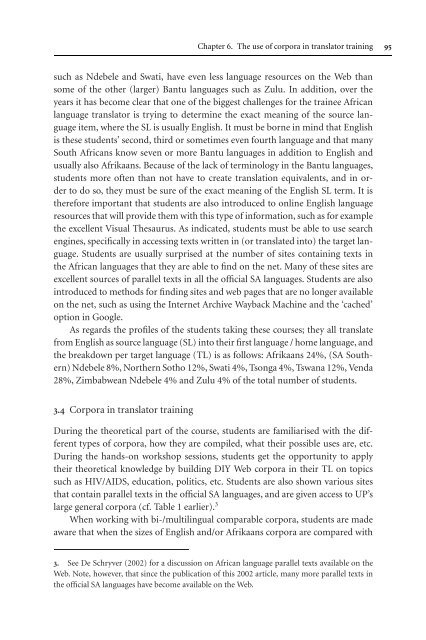Topics in Language Resources for Translation ... - ymerleksi - home
Topics in Language Resources for Translation ... - ymerleksi - home
Topics in Language Resources for Translation ... - ymerleksi - home
- No tags were found...
Create successful ePaper yourself
Turn your PDF publications into a flip-book with our unique Google optimized e-Paper software.
Chapter 6. The use of corpora <strong>in</strong> translator tra<strong>in</strong><strong>in</strong>g 95such as Ndebele and Swati, have even less language resources on the Web thansome of the other (larger) Bantu languages such as Zulu. In addition, over theyears it has become clear that one of the biggest challenges <strong>for</strong> the tra<strong>in</strong>ee Africanlanguage translator is try<strong>in</strong>g to determ<strong>in</strong>e the exact mean<strong>in</strong>g of the source languageitem, where the SL is usually English. It must be borne <strong>in</strong> m<strong>in</strong>d that Englishis these students’ second, third or sometimes even fourth language and that manySouth Africans know seven or more Bantu languages <strong>in</strong> addition to English andusually also Afrikaans. Because of the lack of term<strong>in</strong>ology <strong>in</strong> the Bantu languages,students more often than not have to create translation equivalents, and <strong>in</strong> orderto do so, they must be sure of the exact mean<strong>in</strong>g of the English SL term. It isthere<strong>for</strong>e important that students are also <strong>in</strong>troduced to onl<strong>in</strong>e English languageresources that will provide them with this type of <strong>in</strong><strong>for</strong>mation, such as <strong>for</strong> examplethe excellent Visual Thesaurus. As <strong>in</strong>dicated, students must be able to use searcheng<strong>in</strong>es, specifically <strong>in</strong> access<strong>in</strong>g texts written <strong>in</strong> (or translated <strong>in</strong>to) the target language.Students are usually surprised at the number of sites conta<strong>in</strong><strong>in</strong>g texts <strong>in</strong>the African languages that they are able to f<strong>in</strong>d on the net. Many of these sites areexcellent sources of parallel texts <strong>in</strong> all the official SA languages. Students are also<strong>in</strong>troduced to methods <strong>for</strong> f<strong>in</strong>d<strong>in</strong>g sites and web pages that are no longer availableon the net, such as us<strong>in</strong>g the Internet Archive Wayback Mach<strong>in</strong>e and the ‘cached’option <strong>in</strong> Google.As regards the profiles of the students tak<strong>in</strong>g these courses; they all translatefrom English as source language (SL) <strong>in</strong>to their first language / <strong>home</strong> language, andthe breakdown per target language (TL) is asfollows:Afrikaans24%,(SASouthern)Ndebele 8%, Northern Sotho 12%, Swati 4%, Tsonga 4%, Tswana 12%, Venda28%, Zimbabwean Ndebele 4% and Zulu 4% of the total number of students.3.4 Corpora <strong>in</strong> translator tra<strong>in</strong><strong>in</strong>gDur<strong>in</strong>g the theoretical part of the course, students are familiarised with the differenttypes of corpora, how they are compiled, what their possible uses are, etc.Dur<strong>in</strong>g the hands-on workshop sessions, students get the opportunity to applytheir theoretical knowledge by build<strong>in</strong>g DIY Web corpora <strong>in</strong> their TL on topicssuch as HIV/AIDS, education, politics, etc. Students are also shown various sitesthat conta<strong>in</strong> parallel texts <strong>in</strong> the official SA languages, and are given access to UP’slarge general corpora (cf. Table 1 earlier). 3When work<strong>in</strong>g with bi-/multil<strong>in</strong>gual comparable corpora, students are madeaware that when the sizes of English and/or Afrikaans corpora are compared with3. See De Schryver (2002) <strong>for</strong> a discussion on African language parallel texts available on theWeb. Note, however, that s<strong>in</strong>ce the publication of this 2002 article, many more parallel texts <strong>in</strong>the official SA languages have become available on the Web.
















